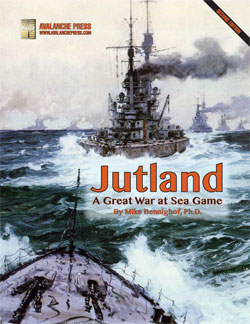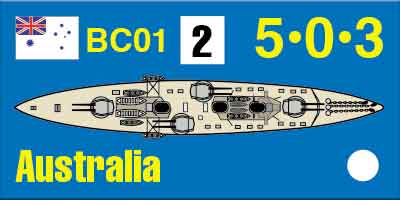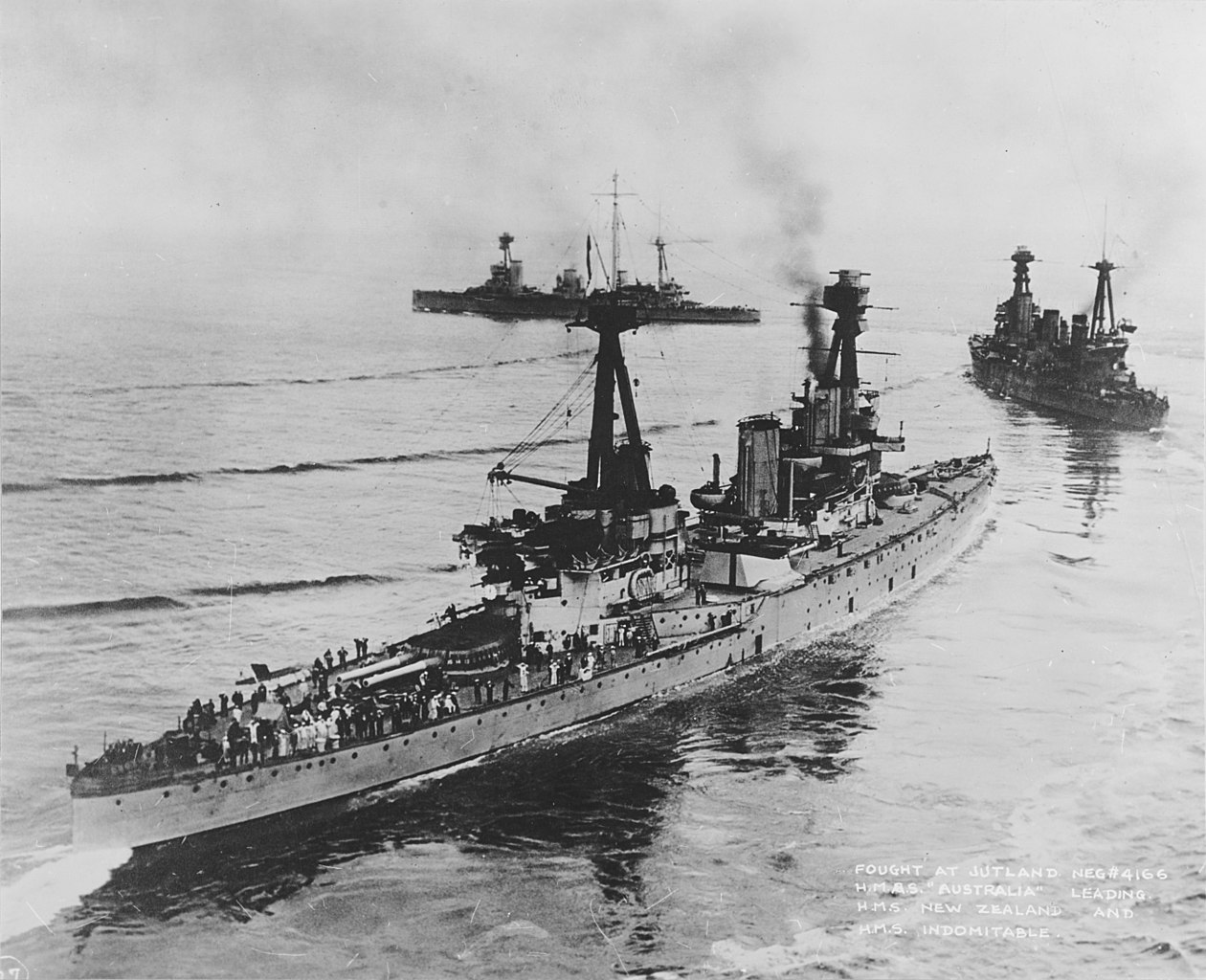| Australia’s
Battle Cruiser
By Mike Bennighof, Ph.D.
February 2023
 In the summer of 1909, the Royal Navy faced
increasing pressure to increase its fleet
of modern dreadnought battleships and battle
cruisers while maintaining its commitments
around the globe. To help meet this and spread
the costs, the British government proposed
that Australia, New Zealand, South Africa
and Canada each fund and man a squadron of
one new armored cruiser, three light cruisers
and six destroyers. In the summer of 1909, the Royal Navy faced
increasing pressure to increase its fleet
of modern dreadnought battleships and battle
cruisers while maintaining its commitments
around the globe. To help meet this and spread
the costs, the British government proposed
that Australia, New Zealand, South Africa
and Canada each fund and man a squadron of
one new armored cruiser, three light cruisers
and six destroyers.
Of the four, only Australia took up the
full proposal. One armored cruiser and three
smaller cruisers would be ordered immediately,
for construction in British shipyards. The
Australian government would pay for their
construction and upkeep, and they would be
manned by Australian personnel. During wartime,
they would be at the disposal of the British
Admiralty. New Zealand could not meet the
same level of commitment, but did agree to
fund a new armored cruiser and present it
to the Royal Navy. South Africa and Canada
rejected the proposal outright.
At the time of the conference, Britain’s
most recent armored cruiser, Defence, had
been commissioned in February — after a considerable
delay as resources went instead to the new
battle cruisers of the Invincible class.
The third battle cruiser completed in March
1909, and one more, Indefatigable, had been
laid down in February to a slightly improved
design.

Events were moving quickly when the two
Dominions made their offers. The Admiralty
intended to order two capital ships under
the 1908 program, the battleship Neptune and the battle cruiser Indefatigable. The
1909 program initially was to also include
two battleships, near-sisters of Neptune,
and the two battle cruisers provided by New
Zealand and Australia. Rumors of increases
in the German building program sparked public
pressure for eight new ships rather than
four (or two, depending on who was doing
the counting). Six additional ships were
added to the 1909 program: four “super dreadnoughts” of the Orion class, and
two battle cruiser equivalents, Lion and Princess Royal.

Australia leads New Zealand and Indomitable out of Rosyth.
Although Lion was laid down nine months
before Australia and New
Zealand, the two
Dominion ships repeated the inferior Indefatigable design as originally ordered. Lion was a
far more capable ship, almost half again
as large with much greater firepower. Not
willing to lose the commitments, the Admiralty
did not press the Dominions to switch to
the more expensive Lion (£2.1 million as
opposed to £1.7 million for the smaller battle
cruiser), even though the Dominions had budgeted
two million each for the cruisers. This failure
left Royal Navy with far less capable ships
when war erupted five years later.
Australia completed in June 1913, and sailed
for her homeland the next month, stopping
at Capetown for a visit carefully calculated
to show the Union's leadership what they
were missing. She served as flagship of the
new Royal Australian Navy for less than a
year before war broke out and she took on
a major role in its early weeks. Maximilian
Reichsgraf von Spee’s German East Asia Squadron
was on the loose in the Pacific, and Australia was faster than any of his ships and capable
of blowing all of them out of the water.
At 18,500 tons, Australia was bigger than
either of Spee’s 12,800-ton armored cruisers.
She could make almost 27 knots, a considerable
edge in speed, and her eight 12-inch guns
gave her greater firepower than any ship
in the Pacific except the newest Japanese
battleships. Rather than deploy the big cruiser
to hunt down and eliminate the threat posed
by Spee to Allied commerce and military convoys,
the Admiralty kept Australia tied to the
invasions of German New Guinea and Samoa.
Not until Spee wiped out Sir Christopher
Cradock’s cruiser squadron was Australia ordered to pursue, heading for South America
on 1 November. She was still on her way when
two British battle cruisers annihilated Spee’s
ships, and suffered grounding damage in the
Straits of Magellan on New Year's Day. She
also sank a German supply ship along the
way.

Australia launches a Sopwith Strutter, 1918.
Australia arrived in England on 28 January
1915, four days after the Battle of Dogger
Bank, and in early February she re-deployed
to Rosyth, Scotland as flagship of the Second
Battle Cruiser Squadron. She participated
in numerous Grand Fleet operations, and on
22 April 1916 rammed her sister New Zealand during heavy fog. She spent the next six
weeks under repair, missing the Battle of
Jutland. Australia served as squadron flagship
for the rest of the war and led one of the
two long columns of Allied warships that
accepted the surrender of the German High
Seas Fleet in November 1918, but Australia had never fired her guns in anger.
She returned home the following spring,
arriving in Freemantle in May 1919. A few
days later, part of the crew mutinied when
ordered to sail for Sydney — they had not
had their fill of the joys of Perth. Five
crewmen were sentenced to prison terms, but
all were released by the end of the year.
The big cruiser conducted training cruises
but soon grew too expensive for the peacetime
budget and she went into reserve at the end
of 1921. The following year, she was sacrificed
at the Washington naval limitations talks,
designated for destruction to end the economically-crippling
world naval arms race.
Towed off Inner South Head near Sydney,
the battle cruiser was scuttled in April
1924. “In her passing she symbolizes
our contribution to the cause of peace,” Prime
Minister Stanley Bruce speechified. “We shall
never forget that in the eventful days of
1914, when the fate of civilization hung
in the balance, it was the presence in the
Pacific of the Australia, manned by Australian
seamen, that saved our shores and our shipping
from the fate which overtook less fortunate
nations.”
Australia’s sacrifice had not been popular
within the Royal Australian Navy, with some
officers arguing that she should not be counted
against the British force total. The RAN
compensated for her loss with two new County-class
heavy cruisers, but many with the small corps of Australian naval officers never fully accepted
the destruction of the ship when she remained
in excellent condition, having taken no battle
damage.
Order Jutland second edition here.
Please allow an extra three weeks for delivery.
Sign up for our newsletter right here. Your info will never be sold or transferred; we'll just use it to update you on new games and new offers.
Mike Bennighof is president of Avalanche Press and holds a doctorate in history from Emory University. A Fulbright Scholar and NASA Journalist in Space finalist, he has published a great many books, games and articles on historical subjects; people are saying that some of them are actually good.
He lives in Birmingham, Alabama with his wife, three children, and his new puppy. His Iron Dog, Leopold, could swim very well.
Want to keep Daily Content free of third-party ads? You can send us some love (and cash) through this link right here.
|
